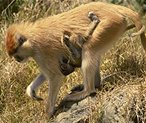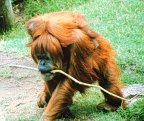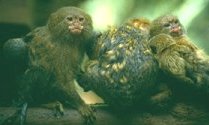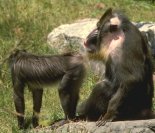Most
primates, including humans, spend their lives in large social groups or
communities. In
the case of semi-terrestrial
![]() species, such as baboons, being in a large community helps provide
protection against predatory cats, dogs, and hyenas. It also helps
protect scarce food resources. This is especially true for non-human primates
when the food is fruit. Leaf-eaters, such as colobus monkeys and
langurs, tend to form smaller social
groupings since there is little competition for their food. The very few
nocturnal species of primates are mostly small, relatively solitary hunters.
There are exceptions to these general patterns. For instance, the
vegetarian orangutans lead mostly solitary lives except for mothers with
their children before they go off on their own.
species, such as baboons, being in a large community helps provide
protection against predatory cats, dogs, and hyenas. It also helps
protect scarce food resources. This is especially true for non-human primates
when the food is fruit. Leaf-eaters, such as colobus monkeys and
langurs, tend to form smaller social
groupings since there is little competition for their food. The very few
nocturnal species of primates are mostly small, relatively solitary hunters.
There are exceptions to these general patterns. For instance, the
vegetarian orangutans lead mostly solitary lives except for mothers with
their children before they go off on their own.
Most non-human primate communities are more or less closed to contact with members of other communities. Most often, they are tied to a particular locale and rarely migrate outside of their home range. This aloofness from other troops prevents high concentrations of individuals which could result in rapid depletion of local resources. Communities usually avoid each other and are aggressive towards outsiders. As a result, social interactions between members of different troops are usually very rare, especially for females. Chimpanzees are a notable exception. When chimpanzees from different troops come together, there is often an exciting, friendly encounter lasting several hours, following which, some of the adult females switch groups. Apparently, they are seeking new mates. Occasionally, however, contact between communities of the comparatively unpredictable chimpanzees will develop into genocidal violence.
 |
|
| Mother- infant
subgroup (patas monkeys) |
Interactions within non-human primate communities are usually unlimited. Subgroups are rarely closed from group interaction. All members of a community have daily face to face, casual communication. The most common type of subgroup consists of a mother and her young offspring.
In some forest living primates, contact between groups of the same species is in the form of a specialized territorial defense behavior. Instead of avoiding each other, groups actively converge near their common territorial border and make hostile displays. Howler monkeys, indris, siamangs, and gibbons all produce exceptionally loud vocalizations for this purpose. This is a ritualized, essentially harmless form of aggression that is intended to intimidate members of the neighboring community. All four of these species live in home ranges that are usually so small that the food resources of neighboring territories can be seen and become attractive.
Non-human Primate Social Group Composition
While there is considerable variation in social group composition among the primates, there is very little variability within each species. In fact, most non-human primate species are limited to only one of the following six basic patterns:
|
1. |
single female and her offspring |
4. |
one-male-several-female group |
|---|---|---|---|
|
2. |
5. |
multimale-multifemale group |
|
|
3. |
6. |
fission-fusion society |
Humans are an exception in that we form a variety of social group patterns. However, each human society usually defines one of them as being acceptable and condemns the others. Only the multimale-multifemale group pattern is not normally found in any human society.
Single
Female and Her Offspring
The single female and her offspring group pattern is rare for primates but common for other mammals. It is found among the orangutans and some of the small nocturnal prosimians (e.g., mouse lemurs and galagos). The adult males lead their lives mostly alone. However, they come together with females occasionally for mating. The males of these species generally have large territories that overlap those of several females. Both male and female children usually leave their mother when they reach sexual maturity.
|
Single
female and |
 |
Monogamous Family Group
Monogamous groups consist of an adult male and female with their children. When they are grown, the children leave to create their own nuclear families. While this group pattern is the most common one for humans, it is rare for non-human primates. It is found among the small Asian apes as well as some of the New World monkeys and prosimians. Specifically, monogamous family groups are the common pattern for gibbons, siamangs, titi monkeys, indris, tarsiers, and apparently some pottos.
Polyandrous Family Group
The smallest New World monkeys, the marmosets and tamarins, form both monogamous and polyandrous family units. They generally start with a monogamous mating pair. Later, a second adult male may join the family and assist in child rearing. When this occurs, both adult males will potentially mate with the adult female. This arrangement is practical because these monkeys commonly have twins and the fathers carry the babies around on their backs most of the time. This polyandrous mating pattern is extremely rare among non-human primates but does occur in some human societies in isolated rural regions of India, Sri Lanka, and especially Nepal, and Tibet.
|
Polyandrous |
 |
One-Male-Several-Female Group
One-male-several-female groups have
polygynous
![]() mating patterns. That is to say, one male
regularly mates and lives with more than one female at a time. Polygyny is generally not a promiscuous mating
pattern. Rather, the male and his female mates form a distinct mating
and child rearing group. This pattern is found among hamadryas
baboons, geladas, langurs, howler monkeys, gorillas and many human
societies. It has been a culturally preferred marriage pattern in
numerous Native American, African, and South Asian cultures. However,
polygyny is not as common among humans as monogamy, even in cultures that
advocate it.
mating patterns. That is to say, one male
regularly mates and lives with more than one female at a time. Polygyny is generally not a promiscuous mating
pattern. Rather, the male and his female mates form a distinct mating
and child rearing group. This pattern is found among hamadryas
baboons, geladas, langurs, howler monkeys, gorillas and many human
societies. It has been a culturally preferred marriage pattern in
numerous Native American, African, and South Asian cultures. However,
polygyny is not as common among humans as monogamy, even in cultures that
advocate it.
It would be a mistake to automatically assume that non-human primate one-male-several-female groups are dominated by males. Among geladas, females largely control the social group. This is despite the fact that the males are larger, stronger, and more aggressive. Mothers, sisters, and aunts act as a team in chasing off other unrelated females. They also collectively select their mutual mate among a number of potential suitors roaming in and out of their territory. The male that is chosen usually is one that does not act abusively towards them and is willing to cooperate with them in defending their territory. The relationship with any particular male may be short-term. The stable core of the community is the group of related females. This is a long way from stereotypical male domination.
One-male-several female groups may take a different form when predator pressure is a problem. In open grasslands, hamadryas baboon communities are much larger, usually consisting of a number of polygynous families. In such multiple one-male-several-female group societies, males are the dominant, controlling members. The adult males not only "herd" their own sexually mature females, but also maintain order and protect the community from predators. This is not unlike the traditional Arab polygynous marriage pattern in which wealthy men acquire harems.
In contrast, gorillas rarely have to be concerned about predator dangers. Subsequently, their communities usually consist of a single dominant adult male, his mates, and their children. When males reach maturity, they usually are driven off by the dominant silverback male. These exiled males ultimately form their own one-male-several-female groups. As females reach sexual maturity, they also leave their natal families and disperse. They later join with single males to form new families or they join the families of males who already have mates. When the silver back males have unusually peaceful personalities, the gorilla community may have several of them.
|
This link takes you to an external website. To return here, you must click the "back" button on your browser program. (length = 22 min. 9 secs.) |
NOTE: The term "silver back" refers to older mature gorilla males who normally develop large silvery-gray saddles of hair on their backs. As they age, the saddles become larger and eventually cover most of their backs.
Multimale-Multifemale Group
The most common social group pattern among semi-terrestrial primates is the multimale-multifemale group. With this pattern, there are no stable heterosexual bonds--both males and females have a number of different mates. This is characteristic of savanna baboons, macaques, as well as some colobus and New World monkey species.
Multimale-multifemale
groups commonly have a dominance hierarchy among both males and females. Each individual is ranked relative to all other community members of the same
gender. This tends to reduce serious violence within the community since
everyone knows in advance who they must defer to and who must be submissive to
them. Among rhesus macaques, one's position in the dominance
hierarchy is determined by the rank of his or her mother. The top
ranking individuals are referred to by primatologists as the
alpha male
![]() and the alpha female. All other community members defer to them. A female's rank
in the hierarchy stays with her throughout life. However, most young
adult male rhesus macaques leave their natal community and ultimately join others to find
mates. When they do so, they start at the bottom of the male dominance
hierarchy again. Alpha males usually mate more often than others.
This makes the social organization superficially look like
one-male-several-female group. However, younger females often sneak off
to mate with males lower down on the dominance hierarchy. The stable core of rhesus macaque
communities is the group of female relatives. They stay within their
natal community throughout life and work as a team to defend it against other
females.
and the alpha female. All other community members defer to them. A female's rank
in the hierarchy stays with her throughout life. However, most young
adult male rhesus macaques leave their natal community and ultimately join others to find
mates. When they do so, they start at the bottom of the male dominance
hierarchy again. Alpha males usually mate more often than others.
This makes the social organization superficially look like
one-male-several-female group. However, younger females often sneak off
to mate with males lower down on the dominance hierarchy. The stable core of rhesus macaque
communities is the group of female relatives. They stay within their
natal community throughout life and work as a team to defend it against other
females.
Advancing up the male dominance hierarchy in baboon communities is comparatively less peaceful than among macaques. Adult male baboons must constantly face challenges from other males who would take away their mates. These confrontations are usually noisy and violent. The fights often result in serious injuries caused by their exceptionally long canine teeth. The higher a male ascends the dominance hierarchy, the more challenges he must answer. As a consequence, alpha males are often under greater physical and psychological stress than lower ranked ones. This results in much higher levels of glucocorticoid stress hormones in their blood, which can result in impaired immune systems. The upside of being a baboon alpha male is more sexual access to females. The downside is a highly stressful life. Health problems resulting from social stress are not limited to males, as the following video shows.
|
related to changes in social ranking among primates can affect an individual's immune system. To return here, you must click the "back" button on your browser program. (length = 53 secs.) |
Fission-Fusion Society
A fission-fusion society is one in
which the social group size and composition change throughout the year with
different activities and situations. This is the social pattern
typical of chimpanzees. Individuals enter and leave communities from
time to time. Adult males occasionally wander off and forage alone or
join a few other males in a hunting party. Females casually change
membership from one group to the other. This occurs especially when
females are in estrus
![]() and seeking mates. As a result, foraging and sleeping groups reform
frequently. Male chimps are the relatively stable core of the
community since they rarely join other troops.
and seeking mates. As a result, foraging and sleeping groups reform
frequently. Male chimps are the relatively stable core of the
community since they rarely join other troops.
What allows for the generally loose relationship between chimpanzee communities is that they apparently recognize a wider range of social bonds than do monkeys. They often have relatives and friends in several different neighboring troops. When chimpanzee communities come together, they usually exchange friendly greetings rather than show aggression. However, it would be a mistake to assume from this that chimpanzee society is always peaceful. The adult males within each community are frequently engaged in complex political activities involving scheming and physical intimidation in order to move up the dominance hierarchy. They develop short-term alliances with other males by mutual support, sharing meat, and allogrooming (grooming others). It isn't always the largest and strongest males who make it to the top of the hierarchy. Often teamwork used to frighten and impress is more effective than any one individual's muscles in achieving chimpanzee goals. This is an indication of their intelligence.
Chimpanzees are not the only primates that change group membership from time to time. For instance, most adult rhesus macaque males permanently leave the community of their birth and try to join others in order to find mates. This is not easy since they are not warmly welcomed in their adoptive troop. Group composition of some langur and baboon species also change as a result of the availability of food and mates. Evidently, none of these monkey species change group composition with the ease and frequency of chimpanzee females. As a result, their societies are not usually referred to as fission-fusion types.
| Social Group Pattern | Primate Species Following This Pattern |
| single female and her offspring | orangutans, some
of the
small nocturnal prosimians (mouse lemurs and galagos), and some humans |
| monogamous family group | some
New World
monkeys (titi monkeys), some prosimians (indris, tarsiers, and some pottos), the small Asian apes (gibbons, siamangs), and some humans |
| polyandrous family group | the
smallest New World monkeys (marmosets and tamarins) and some humans |
| one-male-several-female group | hamadryas
baboons, geladas, langurs, howler monkeys, gorillas, and some humans |
| multimale-multifemale group | savanna baboons, macaques, colobus, and
some New World monkeys |
| fission-fusion society | chimpanzees |
Kinship
Kinship refers to relationships
that are recognized between individuals based on family ties. Among
humans, those ties are created by marriage and shared descent from
ancestors. Among non-human primates, they are due to descent.
Most
non-human primates apparently only recognize matrilineal descent
![]() .
That is,
they know who their mother is but not their father. Socially recognized
paternity is unimportant or non-existent for them. The strongest social unit is a
mother and her young children. Chimpanzees maintain their bonds with
their mother well into adulthood. When they are threatened by others,
even large male chimpanzees may go to their aged mother to be soothed by
grooming. As mentioned earlier, the social ranking of juvenile rhesus
macaques precisely corresponds to the ranking of their mothers. Shared
descent from the same female is also the basis of close relationships
between macaque sisters, aunts, and nieces. Another
indication of the recognition of matrilineal descent is the fact that incest
in the form of mother-son mating is rare for primates.
.
That is,
they know who their mother is but not their father. Socially recognized
paternity is unimportant or non-existent for them. The strongest social unit is a
mother and her young children. Chimpanzees maintain their bonds with
their mother well into adulthood. When they are threatened by others,
even large male chimpanzees may go to their aged mother to be soothed by
grooming. As mentioned earlier, the social ranking of juvenile rhesus
macaques precisely corresponds to the ranking of their mothers. Shared
descent from the same female is also the basis of close relationships
between macaque sisters, aunts, and nieces. Another
indication of the recognition of matrilineal descent is the fact that incest
in the form of mother-son mating is rare for primates.
Gender Differences
 |
|
|
Extreme
sexual dimorphism |
Behavioral
differentiation of male and female primates involves more than just mating
behavior. Males are usually larger and physically dominant over
females. Extreme sexual dimorphism
![]() is particularly characteristic of the
semi-terrestrial monkeys and the great apes. The manner in which male and female
children are socialized often differs. Following infancy, age-based play
groups are usually the primary socializing group for males. These
juvenile male cohorts often spend much of their time on the fringes of the
troop territory in active physical play. For example, nearly half of the waking
hours of young male gorillas are spent in rough play. This is comparable
to the amount of time human children play if given the opportunity. For
most non-human primates, play is critical for developing social bonds and
social skills. Young female monkeys and apes are more often socialized in the
safer areas of the community territory by their mothers and
other older female relatives. Their play is usually less rough and
focuses more on developing parenting skills and social ties among the females
with whom they usually spend their lives. As adults, male primates are more likely
to leave the community to join roaming bachelor groups and eventually join
other communities. Chimpanzees are somewhat of an exception. While
male chimpanzees often roam, it is the females who switch communities.
However, they usually stay physically close to their own mothers until they
become sexually mature around 11 years of age or somewhat later.
is particularly characteristic of the
semi-terrestrial monkeys and the great apes. The manner in which male and female
children are socialized often differs. Following infancy, age-based play
groups are usually the primary socializing group for males. These
juvenile male cohorts often spend much of their time on the fringes of the
troop territory in active physical play. For example, nearly half of the waking
hours of young male gorillas are spent in rough play. This is comparable
to the amount of time human children play if given the opportunity. For
most non-human primates, play is critical for developing social bonds and
social skills. Young female monkeys and apes are more often socialized in the
safer areas of the community territory by their mothers and
other older female relatives. Their play is usually less rough and
focuses more on developing parenting skills and social ties among the females
with whom they usually spend their lives. As adults, male primates are more likely
to leave the community to join roaming bachelor groups and eventually join
other communities. Chimpanzees are somewhat of an exception. While
male chimpanzees often roam, it is the females who switch communities.
However, they usually stay physically close to their own mothers until they
become sexually mature around 11 years of age or somewhat later.
Within their own communities, male chimpanzees spend much of their time scheming in order to move up in dominance. The successful ones usually accomplish this by forming temporary alliances with a few other males in order to physically dominate the rest. These alliances are often created by sharing meat and other prized foods as well as grooming each other. Female chimpanzees apparently do not take part in this constantly changing, often violent political restructuring of their community.
An even darker side of male chimpanzee behavior is that they occasionally murder members of other chimpanzee communities. Groups of males periodically go on aggressive raids into neighboring territories where they isolate individual males and then violently beat and bite them to death. Over time, these marauding gangs will kill all of the males in the targeted communities if they can. They also have been observed eating the infants there, but they usually leave their mothers alone. This behavior has been recorded at several locations in East Africa. The motivations of the killers is not entirely clear, but the net effect is to increase their territory and food resources and at the same time reduce competition for potential mates. This kind of murderous behavior is, of course, reminiscent of humans as well. There are many instances of it in our own history.